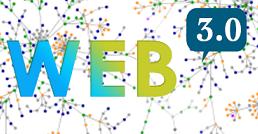WEB 3.0
The notion of the web is used to name a computer network and, especially, the Internet . The idea of web 3.0 refers to a kind of extension or particular format of the traditional network.

It is important to bear in mind that the concept does not have a specific definition, but is often the subject of debate among specialists. In principle, to understand what web 3.0 is, you have to know what the two previous "versions" of the web refer to .
The web 1.0 is Internet in its classical sense: decentralized network of computers (PCs), linked through a specific protocol. Entering the website of a newspaper would be an example of the typical operation of web 1.0: the information is on a computer and users, through another computer, access a copy of it to read it locally.
The web 2.0 is linked to the services that allow you to share data and interact with ease. Social media and collaboration platforms are the foundation of this evolution of the Internet.
The idea of web 3.0 , in this context, is related to what is known as the semantic web . Users and computers, in this framework, can interact with the network through a natural language , interpreted by the software . In this way, accessing the information is easier. In other words, all data hosted on web 3.0 should be "understood" by machines, which could process it quickly.
Web 3.0, in short, is related to artificial intelligence . The websites would even have the ability to connect with each other according to the interests of the user.
In the first place, the reason that there is no formal definition or a single definition of web 3.0 is because many people are working on their own vision of the future of the Internet , so each one expects different changes and improvements in the web browsing experience .
Returning to the evolution of the Internet, we can say that at the beginning each site had its own information and did not share it with others: text and images, for example, which were part of the code itself and, therefore, were indivisible from the page itself. the one that was shown.
 The databases changed everything, since the content was detached from the pages to be published on as many sites as the law allows; just the possibility of showing our friends the article or the video that we have just enjoyed through social networks would have seemed impossible at the beginning of the 90s, and that is why it is necessary to talk about web 2.0 when referring to the dynamism of the data. The next step, as can already be seen in certain cases, is to improve accessibility.
The databases changed everything, since the content was detached from the pages to be published on as many sites as the law allows; just the possibility of showing our friends the article or the video that we have just enjoyed through social networks would have seemed impossible at the beginning of the 90s, and that is why it is necessary to talk about web 2.0 when referring to the dynamism of the data. The next step, as can already be seen in certain cases, is to improve accessibility.
One of the barriers that Web 3.0 tries to break down is the need for human operators to evaluate and manage content on the Internet. This is not new, since several companies, among which Google stands out for the popularity of its products, have been researching and developing artificial intelligence technologies for years to make browsing increasingly fluid and enriching.
We can now access the Internet from a myriad of different devices, and this variety brings many new challenges for developers, both in terms of website aesthetics and technical issues related to applications and data transfer. Web 3.0 aims for everyone to enjoy information and Internet tools regardless of the device through which we connect, since it seeks flexibility and versatility that overcome the barriers of format and structure.
Comments
Post a Comment